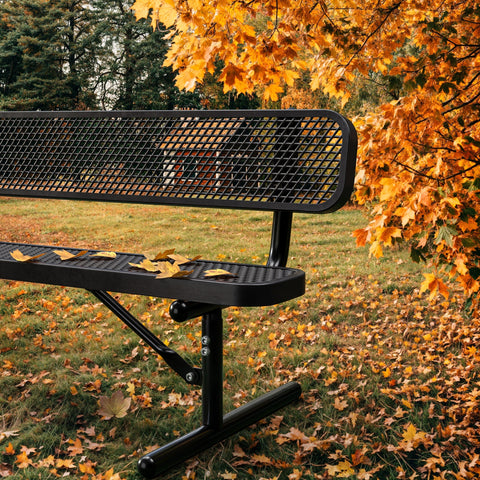Thermoplastic Coated Metal vs Wood, Plastic & Aluminium: Best Picnic Tables Explained
Introduction
Choosing the best outdoor furniture material goes far beyond looks. Whether you’re equipping a public park, school, or residential patio, the right choice affects comfort, maintenance, and lifetime value.
At OUTTANS, we specialize in thermoplastic-coated metal picnic tables and benches—built to withstand the toughest outdoor conditions while maintaining a modern, polished look. But how do they compare to wood, HDPE plastic, or aluminum furniture?
Let’s dive in.
Material Overview
| Material | Durability | Maintenance | Weight | Weather Resistance | Comfort | Ideal Use |
|---|---|---|---|---|---|---|
| Thermoplastic-Coated Steel | ★★★★★ | Very Low | Heavy | Excellent | High | Public spaces, schools |
| Wood (Pine, Cedar, Teak) | ★★★★☆ | Moderate to High | Medium | Good (treated) | Excellent | Homes, hotels |
| Plastic / HDPE | ★★★★☆ | Very Low | Medium | Excellent | High | Coastal areas, patios |
| Aluminum | ★★★★☆ | Low | Light | Excellent | Good | Rooftops, marinas |
1. Thermoplastic-Coated Metal (Steel)
Thermoplastic-coated steel is the backbone of commercial-grade park furniture. Steel’s natural strength, combined with a thick layer of protective thermoplastic, creates a product that lasts for decades.
Shop examples:
Pros
-
Outstanding Durability: The thick thermoplastic coating resists scratches, moisture, and UV damage.
-
Weatherproof: Perfect for year-round use in any climate.
-
Low Maintenance: Wipes clean with soap and water—no paint or stain needed.
-
Anti-Vandal Surface: Expanded or perforated surfaces discourage graffiti and are easy to clean.
-
Long Lifespan: Steel structure + coating = decades of reliable service.
Cons
-
Heavy: Not easily portable, which is also an advantage for public settings (less theft or movement).
-
Heat Retention: Darker colors can feel warm in direct sunlight.
2. Wood (Pine, Cedar, Teak)
Wood remains a classic choice for outdoor furniture thanks to its warmth and natural beauty. However, not all woods perform equally outdoors.
Pros
-
Aesthetic Appeal: Offers a timeless, organic look that suits both rustic and upscale spaces.
-
Comfortable: Doesn’t overheat or feel cold.
-
Repairable: Sanding and refinishing can restore its original charm.
-
Teak Durability: Teak naturally resists moisture, pests, and UV rays.
Cons
-
Maintenance Required: Needs oiling or sealing every 1–2 years.
-
Susceptible to Decay: Cheaper woods like pine need protection from rot.
-
Color Fades: Without care, wood weathers to a silver-grey tone.
Best for: Private gardens, restaurants, or resorts that want natural aesthetics.
3. Plastic / HDPE (Polywood-Style)
HDPE (High-Density Polyethylene) is a heavy-duty plastic made from recycled materials, offering incredible resistance to weather and moisture.
Pros
-
Zero Maintenance: Doesn’t crack, rot, or peel.
-
Weatherproof: Resistant to salt, snow, and rain.
-
Comfortable Surface: Stays moderate in heat and cold.
-
Eco-Friendly: Often made from recycled plastics.
Cons
-
Flexibility: Can warp slightly under heavy load if unsupported.
-
Appearance: Some prefer the look of metal or wood.
-
Cost: Premium HDPE furniture can be pricey.
4. Aluminium
Aluminium offers a modern, sleek appearance and is a great option for those who need lightweight and corrosion-resistant furniture.
Pros
-
Lightweight: Easy to move and rearrange.
-
Corrosion-Resistant: Naturally forms a protective oxide layer.
-
Low Maintenance: Wipe clean, no repainting required.
-
Modern Design: Clean lines, minimalistic look.
Cons
-
Less Rigid: Requires thicker frames to achieve the same stiffness as steel.
-
Visible Scratches: Surface damage shows more easily.
Thermoplastic vs Plastisol Coating
While both are used in outdoor steel furniture, they differ in texture and environmental profile:
-
Thermoplastic coating: Matte, eco-friendly, PVC-free, hides scratches better.
-
Plastisol coating: Thicker, rubbery texture, contains PVC.
Thermoplastic is often preferred for modern public installations because it combines strength, comfort, and sustainability.
Steel, Galvanization, and Coatings
Coated steel furniture is protected in two layers:
-
Zinc galvanization prevents rust from the inside out.
-
Powder or thermoplastic coating adds an impermeable barrier that resists weather, salt, and UV exposure.
This dual system is why OUTTANS metal picnic tables are trusted for parks, schools, and community spaces.
Which Material Should You Choose?
| Setting | Recommended Material | Why |
|---|---|---|
| Public Parks & Schools | Thermoplastic-Coated Steel | Heavy, vandal-resistant, ultra-durable |
| Coastal or Humid Areas | Aluminium or HDPE | Won’t rust, easy care |
| Homes & Restaurants | Wood (Teak) | Warm look, classic feel |
| Moveable Seating Areas | Aluminum | Lightweight & corrosion-proof |
For demanding, all-season use, thermoplastic-coated metal remains the industry standard for commercial outdoor furniture.
Care & Maintenance Tips
-
Coated Steel: Clean with mild soap and water. Avoid abrasives.
-
Wood: Re-seal or oil annually.
-
HDPE: Hose off occasionally.
-
Aluminium: Check powder coat for chips and touch up if needed.
Conclusion
Every material has its strengths—but for long-term performance, minimal maintenance, and public safety, thermoplastic-coated steel is the proven choice.
Explore the full collection of OUTTANS metal picnic tables and benches to find designs that combine durability, design, and sustainability for your outdoor spaces.
Bibliography (Sources)
-
Expanded vs Perforated Metal Strength Comparison – PerforatedSheetsMetal.com
- OUTTANS Product References

